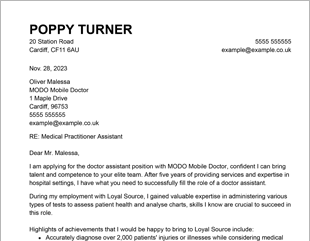Scholarship Cover Letter Examples & Writing Tips
Scholarships often require a short written letter that explains why you’re the best choice for the scholarship. Here’s a scholarship cover letter example to help you write your letter.
Scholarships often require a short written letter that explains why you’re the best choice for the scholarship. Here’s a scholarship cover letter example to help you write your letter.





OUR USERS HAVE BEEN HIRED BY

Start your cover letter off with your contact information, including your phone number, in the header. Address the letter to a specific person if possible, rather than using a generic term like “To whom it may concern.” In this example, the applicant has addressed it to the “Scholarship Committee,” likely indicating that more than one person is reading it. From there, here’s how you can use this cover letter format.
First paragraph: Introduce yourself with a hook
This cover letter starts by explaining why the applicant is applying. She states what the application is for – researchers with chronic illnesses – and then goes on to explain her own chronic illness, as well as why research in this field could be beneficial. This immediately positions her as the best candidate for the scholarship, as not only does she fit the criteria, but she showcases that research is badly needed in this area.
Second paragraph: Give more information about how you’re the best fit for the scholarship
The next paragraph moves on to more detailed information about why this applicant is the best fit for this scholarship. She mentions that many people with Ehlers-Danlos Syndrome have a more difficult time with their diagnoses than she does and that she hopes to help everyone affected by it, not just herself. She also mentions that she’s hoping to study rare diseases specifically, which is often neglected by researchers in the field.
Third paragraph: Call to action
In the closing paragraph, the applicant offers a call to action, stating that she looks forward to sitting down and discussing her research plans with the scholarship committee. She indicates that the financial assistance from the scholarship would be extremely helpful and offers a professional sign-off.
Typically, yes. Scholarships are a bit more individualised than a job application, and if a specific scholarship requires a cover letter, you should send one in. However, if a scholarship doesn’t request a cover letter, you usually shouldn’t submit one. Although cover letters are standard in job applications, they’re not quite as standard in scholarships, and if a scholarship isn’t expecting a letter, you don’t usually need to include one.
This is also very individualised. Typically, a scholarship will indicate a certain word count that you should aim to keep your cover letter in. Unless the scholarship specifically states otherwise, it’s typically not a good idea to go over a single page in your cover letter, and most of these cover letters are very short. Stick to less than a page unless the scholarship committee asks for an especially long cover letter.
Yes. Most cover letter templates should follow this basic three-paragraph format. Notice that this specific scholarship isn’t asking for academic or work experience; it’s just asking for information about your personal life. Because scholarships are mostly meant for financial aid, you won’t usually have to focus on experiences that you might not have.
We personalize your experience.
We use cookies in our website to ensure we give you the best experience, get to know our users and deliver better marketing. For this purpose, we may share the information collected with third parties. By clicking “Allow cookies” you give us your consent to use all cookies. If you prefer to manage your cookies click on the “Manage cookies” link below.